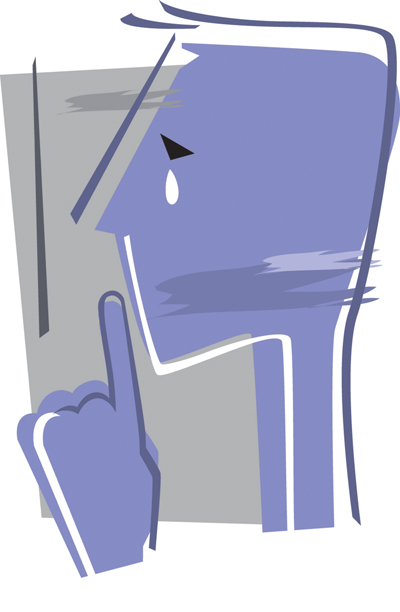Dr. Meena Vimalananda, medical director of child and adolescent services at Sheppard Pratt Health System in Baltimore, calls depression a long and painful illness. She said the pain is deep and remains a source of shame for most people. But better understanding of the illness is leading to improved treatment outcomes.
Dr. Meena Vimalananda, medical director of child and adolescent services at Sheppard Pratt Health System in Baltimore, calls depression a long and painful illness. She said the pain is deep and remains a source of shame for most people. But better understanding of the illness is leading to improved treatment outcomes.
Q:
How do we tell depression apart from a “bad day?”
A:
One bad day happens in most of our lives. Often, a series of bad days happen. When the bad days happen every day for weeks together, that should alert us to pay closer attention.
Changes can be seen in three major areas of life, the interpersonal/home, the work/school and the social/play area. Young folks tend to be irritable. We need not to think, “That is how teenagers are!”
Older people tend to withdraw and become less communicative.
In the early stages, depressed people tend to get in more fights/disagreements with people with whom, usually, they get along. As depression worsens, they isolate themselves.
Kids start to show less interest in school, and their grades tend to drop. Adults are just not as effective at their jobs and people start noticing that they are not all there. Youngsters start using drugs or drinking to feel better and be able to socialize, or lose interest in their earlier leisure activities. Adults tend to keep to themselves and often try to drown their sorrows in alcohol as well.
Q:
How can we tell if someone is suicidal?
A:
By asking if they feel worthless, hopeless or like they wish they were not here or dead. Some people wish to “go to sleep and not wake up.” We should never be afraid to ask, because if we do not ask, most people will not tell us. Do not worry about putting ideas into their heads. Either the ideas are there or they are not.
Q:
When should we seek medical attention?
A:
We should seek medical attention as soon as we feel some concern. If we are concerned, we should talk to our primary-care physicians for referral to a mental health professional who can evaluate and then inform us about actions needed.
If we find that our loved ones have, indeed, put themselves in danger, we should not hesitate to take them to an ER. The earlier we intervene, the clearer the message to the one hurting that we are here to help even if they are not able to ask.
Q:
How common are teen and adult depression?
A:
Teen depression is very common. Adolescent males have the second-highest suicide rate in the country, and a good half of them are accidents. Kids, often, do not know how far they can go, safely. Depression is very common in people in general. It is not clear if the incidence is rising.
What has risen is people’s awareness of it and of the need to intervene rather than to expect people to snap out of it.
Depression is a chemical imbalance in the brain. People may be genetically predisposed (there is a family history of depression), and when faced with overwhelming stress become overtly depressed.
With the fraying of the nuclear family and most homes having two working adults, all family members are more likely to miss those early signs of a downward slide, especially in the age of the video games and computers, when being isolated for hours on end is not unusual.
Q:
How does treatment work?
A:
There are many forms of treatment. Therapy or counseling is where a professional can help one sort through one’s distress and realign supports/priorities/goals to reach a point of being able to function at one’s potential.
Studies have shown that for more severe or longstanding depression, therapy together with antidepressant medication produces the best results. There are several forms of interpersonal therapies used for specific presentations of depression, and professionals are specially trained for these.
In the most extreme, treatment-resistant depressions, electroconvulsive therapy has been life-saving. Still newer forms of treatment have come into recent use but have yet to become mainstream approaches. At the core, the efforts are to reverse the chemistry in the brain that leads to depression in the first place.
Q:
Are there different approaches to treating teens, or gay teens?
A:
There are different approaches to treating teens, as a great deal of their distress and response to such tend to be determined by their social world and their place in it. The tragedies related to youth response to bullying shed much light on this subject. While adults may be able to get their strength from work and other interests, teens rely on each other for validation and support as they venture into the adult world. When that world spits on them, they feel crushed and crumble.
For this reason, some schools run social skills groups so as to teach youngsters empathy for one another. While a lot of kids get bullied, some are more vulnerable than others, and this calls for the adults in their lives to be paying closer attention to them and talking to them every day, for at least a few minutes.
For families, eating together is a great way to demonstrate verbal communication and help children learn to speak their thoughts so they can be heard effectively. Gay teens tend to be even more of a target for teasing because of the community’s overall discomfort with differences in sexual orientation.
As awareness/acceptance of this increases and parents protect their gay kids just as they do their “straight” kids, one can hope that the kids will learn to be respectful toward each other and their differences.










